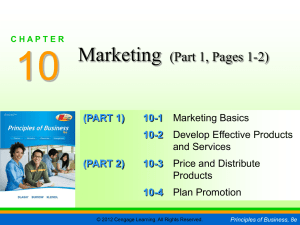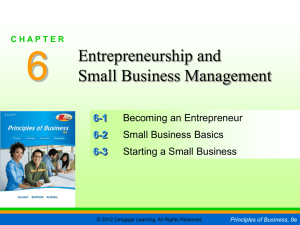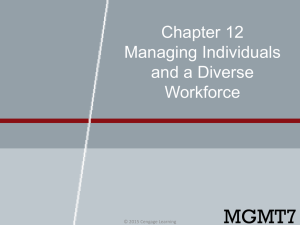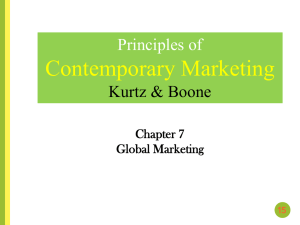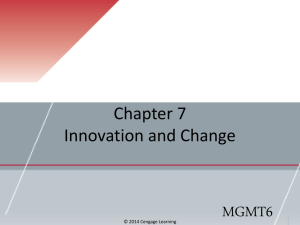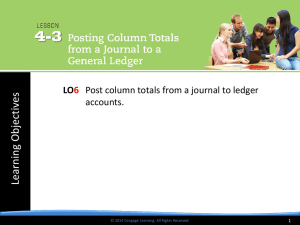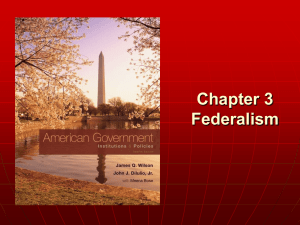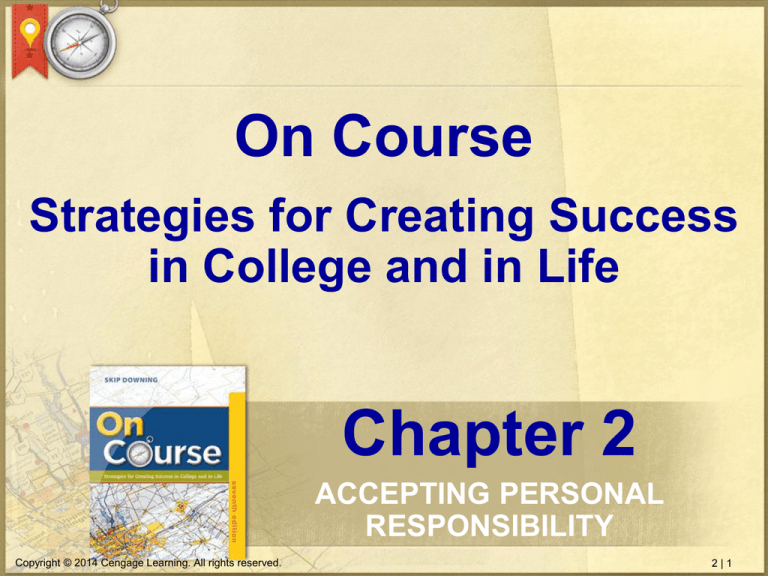
On Course
Strategies for Creating Success
in College and in Life
Chapter 2
ACCEPTING PERSONAL
RESPONSIBILITY
Copyright © 2014 Cengage Learning. All rights reserved.
2|1
CASE STUDY IN CRITICAL THINKING
THE LATE PAPER
Which person in the case study do you think
is most responsible for Kim's failing grade in
Psychology 101? Why?
What choice(s) did Kim make that
sabotaged her success in Psychology 101?
What other choice(s) could she have made?
Dive Deeper: Is there someone not
mentioned in the story who may also bear
responsibility for Kim's failing grade?
Copyright © 2014 Cengage Learning. All rights reserved.
2|2
ACCEPTING PERSONAL RESPONSIBILITY
• Do you accept personal responsibility for creating
the life you want?
• Are you a successful student?
Have you adopted a creator mindset by believing that
your choices create the outcomes and experiences of
your life?
Have you mastered creator language, accepting
personal responsibility for the results?
Do you make wise decisions, consciously designing
the future you want?
Copyright © 2014 Cengage Learning. All rights reserved.
2|3
CRITICAL THINKING: FOCUS QUESTIONS
ADOPTING A CREATOR MINDSET
• What is self-responsibility?
• Why is it the key to creating the life you want?
Copyright © 2014 Cengage Learning. All rights reserved.
2|4
THE VICTIM MINDSET
• A Victim Mindset causes people to believe that what
happens to them is out of their control, that their outcomes
and experiences are determined by such things as luck and
other people.
• Read the following statements and decide if they represent
someone with a Victim Mindset.
Yes
I could never go to college. I don’t even know the
first thing about getting started.
Yes
I wish the college wasn’t so far from my house. I
can’t go to school until I get a car.
No
I have never filled out a college application, but I can
go to the school and ask for help.
Copyright © 2014 Cengage Learning. All rights reserved.
2|5
THE CREATOR MINDSET
• A Creator Mindset causes people to believe they
control their own destiny by the wisdom of their
choices (even though this belief is not always true).
• Read the following statements and decide if they
represent someone with a Creator Mindset.
No
I have never been good in math, so I know I
wouldn’t be able to pass the college entrance exam.
Yes
My best friend's party is this weekend. I think I will
do my homework on Friday instead of on Sunday.
No
I used all my money paying rent and can’t afford to
buy my textbooks. I may have to drop out of college.
Copyright © 2014 Cengage Learning. All rights reserved.
2|6
Why did you miss class?
Copyright © 2014 Cengage Learning. All rights reserved.
2|7
ROSA PARKS
• In 1955, Rosa Parks, an African American woman, was
ordered by a bus driver to give up her seat to a white
passenger. Parks refused and was arrested. A few days
later, African Americans began a boycott of Montgomery
buses that ended when the laws requiring segregation on
public buses was lifted.
Break into groups and discuss how this story relates to
having a Creator Mindset. Be prepared to give a brief
summary of your group’s discussion.
Copyright © 2014 Cengage Learning. All rights reserved.
2|8
Indicate the extent to which each of the following statements applies to you. Use the following scale:
1 = Strongly disagree
2 = Disagree
3 = Slightly disagree
4 = Neither agree nor disagree
5 = Slightly agree
6 = Agree
7 = Strongly agree
1. When I get what I want it’s usually
because I worked hard for it.
2. When I make plans I am almost
certain to make them work.
3. I prefer games involving some luck
over games requiring pure skill.
4. I can learn almost anything if I put
my mind to it.
5. My major accomplishments are
entirely due to my hard work and
ability.
Copyright © 2014 Cengage Learning. All rights reserved.
6. I usually don’t set goals because I
have a hard time following through on
them.
7. Competition discourages
excellence.
8. Often people get ahead just by
being lucky.
9. On any sort of exam or competition
I like to know how well I do relative to
everyone else.
10. It’s pointless to keep working on
something that’s too difficult for me.
2|9
ACTIVITY: RESPONSIBILITY AND CULTURE
• Imagine an imaginary line from one side of the room to the
other. This line represents a continuum of beliefs about
personal responsibility. One end represents the belief that
you determine your own destiny (internal locus of control).
The other end represents the belief that fate or other people
determine your destiny (external locus of control).
Your score places you on the line that best represents
your beliefs.
Copyright © 2014 Cengage Learning. All rights reserved.
2 | 10
RESPONSIBILITY AND CHOICE
QUOTATION
• “When you make the shift to being the predominate
creative force in your life, you move from reacting and
responding to the external circumstances of your life to
creating directly the life you truly want.” ~Robert L. Fritz
Write about a time when you either did or did not act as
if you are the “predominate creative force in your own
life.”
How did this choice affect your life?
Copyright © 2014 Cengage Learning. All rights reserved.
2 | 11
CRITICAL THINKING: FOCUS QUESTION
MASTERING CREATOR LANGUAGE
• How can you create greater
success by changing your
vocabulary?
Copyright © 2014 Cengage Learning. All rights reserved.
2 | 12
SELF TALK: THE INNER CRITIC
• The Inner Critic is the internal voice
that judges us as inadequate, blames
us for whatever is wrong in life, and
can find fault with anything about us.
• How many times does the character
makes an Inner Critic statement?
Copyright © 2014 Cengage Learning. All rights reserved.
2 | 13
SELF TALK: THE INNER DEFENDER
• The Inner Defender judges, blames,
complains, accuses, criticizes and
condemns others.
Write about a time that either you or
someone else made Inner Defender
statements.
Break into groups and discuss your
examples.
Also discuss: What lessons can you
learn from these examples as it applies
to the college environment?
Copyright © 2014 Cengage Learning. All rights reserved.
2 | 14
SELF TALK
• Divide into groups and discuss how the Inner
Critic and Inner Defender are similar and
different? Examples of each.
• Be prepared to share your findings with the
class.
Copyright © 2014 Cengage Learning. All rights reserved.
2 | 15
SELF TALK: INNER GUIDE
• The Inner Guide seeks to make
the best of any situation and
knows that judgments do not
improve difficult situations.
Give an example of when you
faced a difficult situation and
your Inner Guide helped you to
make a wise choice.
What was the outcome or
experience of your choice?
Copyright © 2014 Cengage Learning. All rights reserved.
2 | 16
THE LANGUAGE OF RESPONSIBILITY
• Look over the qualities of Victim and Creator
language in the chart below. What are some
benefits of using Creator language?
Victim Language
Creator Language
Focuses on weaknesses
Focuses on how to improve
Makes excuses
Seeks solutions
Complains
Turns complaints into requests
Compares oneself unfavorably to
others
Seeks help from those more skilled
Blames
Accepts responsibility
Sees problems as permanent
Treats problems as temporary
Repeats ineffective behaviors
Does something new
Tries
Does
Predicts defeat and give up
Thinks positively and looks for a
better choice
Copyright © 2014 Cengage Learning. All rights reserved.
2 | 17
THE LANGUAGE OF RESPONSIBILITY
Change the following Victim language to Creator language
• Our classroom is so cold, I can’t even concentrate.
I don’t want to be distracted by being cold, so I’ll bring an extra sweater to wear
during class.
• My roommate bothers me every night and I can’t study.
I know my roommate is going to want to talk when I get home, so I’ll study in the
library before I leave campus.
• The gym is always so crowded that I can’t work out.
The gym has been really crowded the last few times I went, so I am going to go
at a different time and see if there are fewer people there then.
• No matter how hard I study, I’m just no good in chemistry.
I find chemistry to be challenging, so I’ll go to the chem lab and find out if
there’s a tutor who will help me.
Copyright © 2014 Cengage Learning. All rights reserved.
2 | 18
CRITICAL THINKING: FOCUS QUESTIONS
MAKING WISE DECISIONS
• How can you improve the quality of the decisions
you make?
• How can you take full responsibility for the
outcomes and experiences in your life?
Copyright © 2014 Cengage Learning. All rights reserved.
2 | 19
THE WISE CHOICE PROCESS
• The Wise Choice Process is a 6 step decision
making model that empowers you take full
responsibility for creating the life you want.
Step 1: What is my present situation?
Step 2: How would I like my situation to be?
Step 3: What are my possible choices?
Step 4: What is the likely outcome of each possible choice?
Step 5: Which choice(s) will I commit to doing?
Step 6: When and how will I evaluate my plan?
Copyright © 2014 Cengage Learning. All rights reserved.
2 | 20
THE WISE CHOICE PROCESS
1. What’s my present situation?
(Identify the problem or difficulty.)
2. How would I like my situation to be?
(Define my desired outcomes and
experiences.)
3. What are my possible choices?
(Without evaluating, make a list of options.)
Copyright © 2014 Cengage Learning. All rights reserved.
2 | 21
THE WISE CHOICE PROCESS
4. What’s the likely outcome of each
possible choice?
(Missing information? Stop and get more!)
5. Which choice(s) will I commit to doing?
(Make a promise to myself.)
6. When and how will I evaluate my plan?
(Assess my results.)
Copyright © 2014 Cengage Learning. All rights reserved.
2 | 22
THE WISE
CHOICE PROCESS EXAMPLE
1. What’s my present situation?
I don’t have the $900 it will cost to get my car
fixed, so I have to take the bus or ask
people for rides wherever I go.
2. How would I like my situation to be?
I own a safe, reliable car so I can conveniently
go where I want when I want.
Copyright © 2014 Cengage Learning. All rights reserved.
2 | 23
3. What are my
Possible choices?
4. What’s the likely
outcome of each choice?
1. Work extra hours at my job. 1. Earn more money but have
less time to study.
2. Make out a tighter budget; 2. Save money and have more
stop eating at restaurants.
time to study.
3. Ask Chuck to give me a
ride to campus.
3. Save bus money and
maybe develop a new
friendship.
4. Ask for a raise.
4. Might get more money for
same amount of time,
especially if I do jobs that
others don't like to do.
Copyright © 2014 Cengage Learning. All rights reserved.
2 | 24
THE WISE CHOICE PROCESS
5. Which choice(s) will I commit to doing?
By February 1st, I will develop a budget that will
cut $125.00 off my monthly bills (including not
eating at restaurants), I will ask my supervisor
for a raise, and I will ask Chuck for a ride to
campus until I get my car fixed. I will put all
extra money into a savings account.
6. When and how will I evaluate my plan?
By July 15th, I'll have at least $900 in my savings
account and get my car fixed.
Copyright © 2014 Cengage Learning. All rights reserved.
2 | 25
THE WISE CHOICE PROCESS
• Think of a problem or challenging situation you are
now facing, and write out the steps of the Wise
Choice Process.
Step 1: What is my present situation?
Step 2: How would I like my situation to be?
Step 3: What are my possible choices?
Step 4: What is the likely outcome of each possible
choice?
Step 5: Which choice(s) will I commit to doing?
Step 6: When and how will I evaluate my plan?
Copyright © 2014 Cengage Learning. All rights reserved.
2 | 26
PERSONAL RESPONSIBILITY AT WORK
• If you took responsibility for choosing your ideal
career, how could you get more information
about possible career choices?
• Which of the following would be your first choice
for getting information to help you decide on a
career? Why?
Seek part-time employment doing an entry-level
position in a particular career field.
Talk to others presently in a career field.
Research careers online.
Take a career interest inventory.
Copyright © 2014 Cengage Learning. All rights reserved.
2 | 27
CRITICAL THINKING: FOCUS QUESTION
CHANGE YOUR INNER CONVERSATION
• How can you raise your self-esteem by changing
your self-talk?
Copyright © 2014 Cengage Learning. All rights reserved.
2 | 28
THE CURSE OF STINKIN’ THINKIN’
A + B = C (Activating event + Beliefs = Consequences)
Activating
Event
Belief
Consequence
Which
“internal
voice” does
this sound
like?
Instructor
didn’t show up
for a meeting.
“Instructor thinks I am
dumb. I’ll never finish
college. I’m a failure.”
Got depressed and
wasted the evening.
Which
“internal
voice” does
this sound
like?
Instructor
didn’t show up
for a meeting.
“Instructor wont help
me. Instructor doesn’t
care.”
Got angry and spent
the night
complaining to
friends.
Copyright © 2014 Cengage Learning. All rights reserved.
2 | 29
STINKIN’ THINKIN’ & STEREOTYPE THREAT
• Using A+B=C when faced with Stereotype Threat
Activating
Event
Belief
Consequence
Female student
taking a math
test.
Women are not
good in math.
Female student
What
do you
gets anxious,
think
the
distracted
consequence
and forgets
would
be inshe
this
everything
scenario?
studied.
Copyright © 2014 Cengage Learning. All rights reserved.
2 | 30
DISPUTING IRRATIONAL BELIEFS
• Become familiar with your inner voice
Dispute irrational beliefs dealing with the stereotype
threat that “women are bad in math.”
Offer evidence
that your
judgments are
wrong
Offer a positive
explanation of the
problem
Question the
importance of the
problem
Offer a plan to
improve the
situation
I did pretty well in
high school math
and many women
have great jobs
using math skills
everyday.
When I excel in
math, I’ll have fewer
women to compete
against for jobs.
I don’t have to be the
smartest woman in
the class, I just have
to continue to learn
more everyday.
I’ll study every
What
would
be a
night,
do all
good plan ask
to
homework,
improve
questions
inthe
class,
situation?
go to
tutoring, and
see the instructor
during office hours.
Copyright © 2014 Cengage Learning. All rights reserved.
2 | 31
QUICK REVIEW
• Identify each of the following as Inner Critic, Inner Defender
or Inner Guide statements
I am failing English because the teacher doesn’t know how to explain
things clearly.
Inner
Defender
My car has a flat tire. I’ll ask John if he can give me a ride to school
tomorrow while the tire is being fixed.
Inner
Guide
I’m too clumsy and slow to be on the soccer team at school; they
would laugh at me if I showed up to practice.
Inner
Critic
I know I won’t get the job I interviewed for; I have never been good at
answering questions on the spot.
Inner
Critic
My math book is horrible, so there’s no way anyone can pass that
course.
Inner
Defender
I know I have a habit of procrastinating, so I’m going straight home
today and pay all my bills so I don’t incur late charges.
Inner
Guide
I know I stutter a lot when I get nervous, so I am going to practice my
speech at least one hour every day.
Inner
Guide
My friend said he would buy my textbooks for class, but he didn’t.
Now I’m going to fail and it’s all his fault.
Copyright © 2014 Cengage Learning. All rights reserved.
Inner
Defender
2 | 32
QUICK REVIEW
• Identify each of the following as a
Victim Mindset or as a Creator Mindset.
I’ll never pass math. It’s just too hard.
Victim
My study group is a waste of time.
Victim
I have a meeting with my teacher to discuss
how to improve my grades in English.
Creator
My coworkers like to gossip a lot; I need to
stay to myself so I can get my work done.
Creator
My roommates yell a lot when the football
game is on so I can never concentrate on
my studies.
Victim
Copyright © 2014 Cengage Learning. All rights reserved.
2 | 33
QUICK REVIEW
• People respond differently to certain situations.
Identify each part of the “A + B = C formula”
My instructor didn’t show up for a Activating Event
scheduled meeting.
I’m not sure what went wrong.
Sometimes things just don’t turn out
the way they were planned.
I need to reschedule with my
instructor. Then, I am going to use
this time to study for my history
class and get ahead in my biology
class.
Copyright © 2014 Cengage Learning. All rights reserved.
Belief
Consequence
2 | 34
ONE STUDENT'S STORY:
Dominic Grasseth
What thoughts did Dominic change?
What old classroom behaviors did Dominic
also change?
What choices could you make about your
thoughts or classroom behaviors that would
help you achieve your desired outcomes
and experiences?
Copyright © 2014 Cengage Learning. All rights reserved.
2 | 35
WISE CHOICES IN COLLEGE: READING
• What four things are you Collecting when you
read actively?
Key concepts
Main ideas
Secondary ideas
Supporting details
Copyright © 2014 Cengage Learning. All rights reserved.
SS 2 | 36
CHALLENGES WITH READING
• In groups, make a list of the biggest challenges
you are having with reading assignments for your
present courses?
What are the three most common reading
problems identified by your group?
Copyright © 2014 Cengage Learning. All rights reserved.
SS 2 | 37
STRATEGIES TO IMPROVE READING:
BEFORE READING
• You now know that Prior Learning, Quality of
Processing and Quantity of Processing are
crucial to learning.
In groups, create a list of strategies you could
use to apply these three concepts before
reading an assignment.
Review the next 2 slides and compare your
results.
Copyright © 2014 Cengage Learning. All rights reserved.
SS 2 | 38
STRATEGIES TO IMPROVE READING:
BEFORE READING
• Approach reading with a positive attitude. Quality of
Processing
Attitude is the foundation of your
success. Get your mind in the mood
to learn!
• Create a distributed reading schedule.
Spread your reading over time.
Cramming leads to superficial and
short-lived learning.
• Read when you’re most alert.
Study during your mental peak each
day. Don’t study when you’re tired.
Copyright © 2014 Cengage Learning. All rights reserved.
Quantity of
Processing
Quality of
Processing
SS 2 | 39
STRATEGIES TO IMPROVE READING:
BEFORE READING
• Read where you can concentrate.
Minimize distractions.
Quality of
Processing
• Review past readings.
Make neural connections stronger
by connecting new information to
what you already know.
• Preview before reading.
Relate the new material to what
you have already learned.
Copyright © 2014 Cengage Learning. All rights reserved.
Prior
Learning
Prior
Learning
SS 2 | 40
STRATEGIES TO IMPROVE READING:
BEFORE READING
• When you are previewing your reading, what
should you be looking for?
Diagrams
Titles:
Graphs
Charts
Headings
Copyright © 2014 Cengage Learning. All rights reserved.
SS 2 | 41
STRATEGIES TO IMPROVE READING:
WHILE READING
• What are some strategies you could use to
decrease the amount of time you spend reading?
Read in chunks.
Concentrate on reading faster.
Read for answers to questions on your list.
Copyright © 2014 Cengage Learning. All rights reserved.
SS 2 | 42
STRATEGIES TO IMPROVE READING:
WHILE READING
• How will looking for answers to specific questions
help you while you read?
• How will writing new questions and answers that
you discover while reading, improve your reading?
Copyright © 2014 Cengage Learning. All rights reserved.
SS 2 | 43
STRATEGIES TO IMPROVE READING:
WHILE READING
• If you had to read something about which you
have no interest, what strategy could you use to
avoid mindless reading?
Look for something that is particularly
interesting to you.
or
Look for information that you could use.
In other words, read for IOUs (Interesting or
Useful).
Copyright © 2014 Cengage Learning. All rights reserved.
SS 2 | 44

